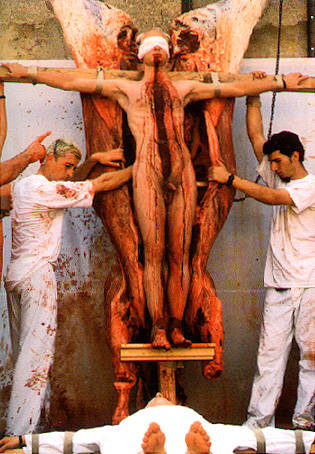
In 1962, Hermann Nitsch locked himself in a basement with two assistants. He crucified a lamb, then proceeded to stage his own crucifixion while one assistant poured animal blood over him, staining the background sheet to produce a "relic." But this wasn't a cultic ritual, this was an exhibition called Blood Organ, and it was just the precursor to performances which have reached festival proportions.
His Das Orgien Mysterien Theater is a full-on bacchanalia of music, blood, wine and drama with all senses operating at once. Raw flesh meets naked revelers as Nitsch sprays blood over the audience, implicating them in the deaths of the bulls, sheep, pigs and other animals, and aiming to damn the mechanisms of repression in our affluent society. As he explains:
"A psychoanalytically-oriented dramaturgy allows the Dionysian to burst forth from within us. Suppressed areas of inner impulses are made visible. The actions with flesh, blood and slaughtered animals plumb the collective areas of our unconscious minds. The paramount aim and purpose of the festival is a profound affirmation of our existence, our life and our creation. The mysticism of being leads to a permanent festival of life."
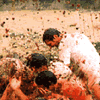 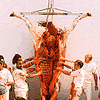 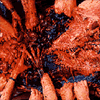 |
All of Hermann Nitsch's previous Aktions (as he calls them) have been rehearsals towards the realization of his 6 Tage-Spiel. "The Six-Day Play is a reenactment of the story of creation," he says, "it is about the Death, and the Resurrection." After 40 years of performances, Nitsch finally reach his longtime goal with the 100th Aktion, August 3-9, 1998, held in the pastoral setting of Castle Prinzendorf, Nitsch's home for the last 30 years. Instructions from Day Three give the flavor of the event:
"All are invited to drink. A mass intoxication is imperative, an all-embracing intoxication of the participants is ordained, unrestrained drinking takes place, day and night, in vineyards and cellars. Slaughter of a pig. GRAPES, FRUIT and TOMATOES, ANIMAL LUNGS, FLESH and INTESTINES are trampled on in ecstasy. People trample in SLAUGHTERED ANIMAL CARCASSES FILLED WITH INTESTINES, in troughs full of blood and wine. Extreme noise from the orchestras. Slaughtering of the bull, slaughtering of two pigs. Disembowelment.
"The participants guzzle more and more. The bull and a man tied before it to a cross are attached to a portable frame and carried to the cellars of Essellsstadt by numerous actors accompanied by musicians. All of the participants are drunk. Tavern music, the orchestras all play loud, ecstatic, roaring music in a continual crescendo."
Over 100 musicians played -- there were marching bands, Gregorian music, church bells, and synthesizers -- as an invading tank (yes, an actual war-sized tank) trampled onto the castle grounds to be doused with both animal blood and roses. The deaths of the three bulls during the play were offered as life for the participants. There was no hiding the fact that the meat came from the death of an animal: This is not a hamburger, this is a dead bull, and you're eating it. The death of the bull also offered an opening to a neural pathway, an excitation and affirmation of one's own state of being.
 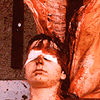 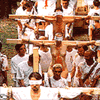 |
As always, the killing in the Aktion was quick, performed by professional butchers under veterinary control, but that has done nothing to silence Nitsch's detractors. Brigitte Bardot, the actress turned animal-rights activist (and friend to the French far right), condemned the man's work as a "satanic spectacle," flying to Austria the week before the Six-Day Play to appeal to the people and government to boycott the show.
Nitsch is used to controversy. The Vienna Opera received over 40 anonymous threats protesting the sets that Nitsch created for the 1995 production of Massenet's Herodiade (Plácido Domingo was in the role of Bautista) even though Nitsch used no blood at all in his constructions. He did use red paint to symbolize the beheading of Bautista, and to create the gigantic paintings used as scenery. At the end of the opera when Bautista's head is held aloft and paraded around by his tormentors, a waterfall of blood cascades forth from a back stage wall to emphasize the beheading. Domingo himself felt that the production had "color" and said that "different experiences" did not frighten him.
Relics from last year's performance have been shipped to the U.S., and the 100th Aktion is being celebrated at an exhibition at the White Box Gallery in New York. During his visit, I was able to have a short conversation with him (and Rita, his lovely wife of 15 years) over dinner and brew. It's quite obvious that he's living the intense life that he wants his Orgies Mysteries Theatre to bring to its participants.
GETTINGIT: You've first introduced the idea of the Six-Day Play in 1957, and said that all of your future actions would be toward this goal of a Six-Day Play. Now that you've reached this six-day event, what's next? Will your actions ever exceed six days?
HERMANN NITSCH: I will be spending more time to realize future actions. This Six-Day Play was an experiment in realizing a six-day action. Future actions will be larger, with more participants, and much more intense. My future actions will always be six days. Some may be shorter, but six days will be the longest action I will ever have.
GI: Is your work today more of a realization of what you were working toward in the '50s?
HN: It's like a tree. As the tree grows, you get branches, and flowers and fruits. I've never locked myself into a particular way of growth. I've used the same tools but I've let the tree grow. Everything grows up with me. I had an idea, and the tools were fixed, but like Schopenhauer -- he had an idea for music when he was very young. As he grew older, he developed and his compositions developed.
GI: Do you oversee everything that occurred at the festival?
HN: I'm not always at every planning meeting, but I've written all the music, the score, and the direction of the events. I have many assistants who I trust to arrange all the various musicians, performers, animals, and eating times. But I first write out all of the events that will occur. I must stress that no one is an actor, everyone is a participant. All the events that occur during the action happen with no direct scripting of what will occur beyond the basic event.
GI: What are some simple pleasures you receive from life, other than the performances?
HN: I keep all of my senses alive. I smell, taste, touch... I eat, I have a big feast at least once a week. I drink until drunk at least once a week. I am very interested in living life to its fullest.
GI: Do you feel that your performances can only exist as the performance itself, or can a videotape or film also work as an expression of your art?
HN: Film and video are only representations of the event. The event is a feast for the senses. It's very important to be in my performance to fully realize my art and my work. Without the smells of the carcasses and flowers, without the taste of the fresh meat and the wine, you are left with very little of the performance. To hear it, to taste it, to feel it, to see it... it is a feast of existence.
GI: Are there any other types of animals you'd like to incorporate into your performances?
HN: I would like to use human cadavers in my performance. I've been trying for years to procure a human body for my theater. Universities for medicine can have cadavers for their research, why can an artist not also have access to such tools? I wouldn't treat a human cadaver any differently than I would the carcass of a bull. It would only be used as a tool for the performance.
GI: What is your relationship with David Bowie? Your name and artwork appeared in the inner sleeve and liner notes for his Outside CD.
HN: I was on a panel of judges for an Outside Art Festival that his company had put together. David Bowie, myself and Christoph Ruecker, a VP at BMG Entertainment International, looked over all the work. David and I agreed on a piece by a young Philippine man, Joseph Lee Alviar, called Destruction of Man.
GI: When is your next Aktion?
HN: We are now planning another Six-Day Play in the next few years. You all must come!
An 80-CD box set chronicling the entire Six Days of Aktion 100 will be available from The Cortical Foundation in the new year. The edition of 30 will contain a valise with the complete 1500-page score, a set of prints, a large relic (a stained canvas from the event mounted on paper), and "a little pharmacy of tastes and smells." Less ambitious Nitsch fans can buy a picture disc LP created to commemorate the exhibition in October of this year in New York ($50, edition of 400, also available in a foil-embossed cloth folio edition, including signed relic for $1000).
Special thanks to Jon Carlson and Greg Scott.
Shade Rupe is the publisher of Funeral Party: A celebratory excursion into beautiful extremes of life, lust, & death.
